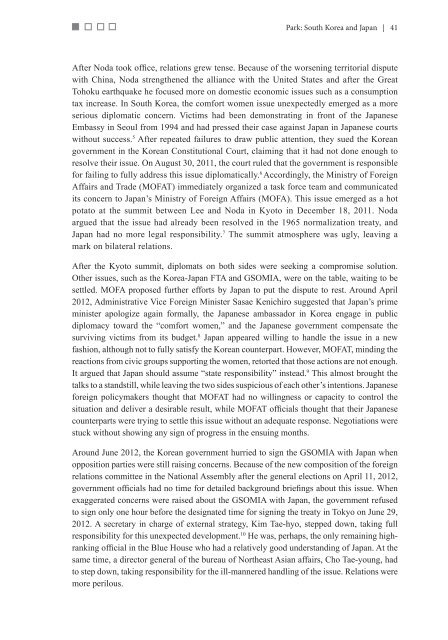the full publication PDF - Korea Economic Institute
the full publication PDF - Korea Economic Institute
the full publication PDF - Korea Economic Institute
Create successful ePaper yourself
Turn your PDF publications into a flip-book with our unique Google optimized e-Paper software.
Park: South <strong>Korea</strong> and Japan | 41<br />
After Noda took office, relations grew tense. Because of <strong>the</strong> worsening territorial dispute<br />
with China, Noda streng<strong>the</strong>ned <strong>the</strong> alliance with <strong>the</strong> United States and after <strong>the</strong> Great<br />
Tohoku earthquake he focused more on domestic economic issues such as a consumption<br />
tax increase. In South <strong>Korea</strong>, <strong>the</strong> comfort women issue unexpectedly emerged as a more<br />
serious diplomatic concern. Victims had been demonstrating in front of <strong>the</strong> Japanese<br />
Embassy in Seoul from 1994 and had pressed <strong>the</strong>ir case against Japan in Japanese courts<br />
without success. 5 After repeated failures to draw public attention, <strong>the</strong>y sued <strong>the</strong> <strong>Korea</strong>n<br />
government in <strong>the</strong> <strong>Korea</strong>n Constitutional Court, claiming that it had not done enough to<br />
resolve <strong>the</strong>ir issue. On August 30, 2011, <strong>the</strong> court ruled that <strong>the</strong> government is responsible<br />
for failing to <strong>full</strong>y address this issue diplomatically. 6 Accordingly, <strong>the</strong> Ministry of Foreign<br />
Affairs and Trade (MOFAT) immediately organized a task force team and communicated<br />
its concern to Japan’s Ministry of Foreign Affairs (MOFA). This issue emerged as a hot<br />
potato at <strong>the</strong> summit between Lee and Noda in Kyoto in December 18, 2011. Noda<br />
argued that <strong>the</strong> issue had already been resolved in <strong>the</strong> 1965 normalization treaty, and<br />
Japan had no more legal responsibility. 7 The summit atmosphere was ugly, leaving a<br />
mark on bilateral relations.<br />
After <strong>the</strong> Kyoto summit, diplomats on both sides were seeking a compromise solution.<br />
O<strong>the</strong>r issues, such as <strong>the</strong> <strong>Korea</strong>-Japan FTA and GSOMIA, were on <strong>the</strong> table, waiting to be<br />
settled. MOFA proposed fur<strong>the</strong>r efforts by Japan to put <strong>the</strong> dispute to rest. Around April<br />
2012, Administrative Vice Foreign Minister Sasae Kenichiro suggested that Japan’s prime<br />
minister apologize again formally, <strong>the</strong> Japanese ambassador in <strong>Korea</strong> engage in public<br />
diplomacy toward <strong>the</strong> “comfort women,” and <strong>the</strong> Japanese government compensate <strong>the</strong><br />
surviving victims from its budget. 8 Japan appeared willing to handle <strong>the</strong> issue in a new<br />
fashion, although not to <strong>full</strong>y satisfy <strong>the</strong> <strong>Korea</strong>n counterpart. However, MOFAT, minding <strong>the</strong><br />
reactions from civic groups supporting <strong>the</strong> women, retorted that those actions are not enough.<br />
It argued that Japan should assume “state responsibility” instead. 9 This almost brought <strong>the</strong><br />
talks to a standstill, while leaving <strong>the</strong> two sides suspicious of each o<strong>the</strong>r’s intentions. Japanese<br />
foreign policymakers thought that MOFAT had no willingness or capacity to control <strong>the</strong><br />
situation and deliver a desirable result, while MOFAT officials thought that <strong>the</strong>ir Japanese<br />
counterparts were trying to settle this issue without an adequate response. Negotiations were<br />
stuck without showing any sign of progress in <strong>the</strong> ensuing months.<br />
Around June 2012, <strong>the</strong> <strong>Korea</strong>n government hurried to sign <strong>the</strong> GSOMIA with Japan when<br />
opposition parties were still raising concerns. Because of <strong>the</strong> new composition of <strong>the</strong> foreign<br />
relations committee in <strong>the</strong> National Assembly after <strong>the</strong> general elections on April 11, 2012,<br />
government officials had no time for detailed background briefings about this issue. When<br />
exaggerated concerns were raised about <strong>the</strong> GSOMIA with Japan, <strong>the</strong> government refused<br />
to sign only one hour before <strong>the</strong> designated time for signing <strong>the</strong> treaty in Tokyo on June 29,<br />
2012. A secretary in charge of external strategy, Kim Tae-hyo, stepped down, taking <strong>full</strong><br />
responsibility for this unexpected development. 10 He was, perhaps, <strong>the</strong> only remaining highranking<br />
official in <strong>the</strong> Blue House who had a relatively good understanding of Japan. At <strong>the</strong><br />
same time, a director general of <strong>the</strong> bureau of Nor<strong>the</strong>ast Asian affairs, Cho Tae-young, had<br />
to step down, taking responsibility for <strong>the</strong> ill-mannered handling of <strong>the</strong> issue. Relations were<br />
more perilous.










